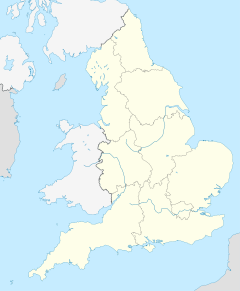Reepham (Norfolk)
| Reepham | ||
|---|---|---|
| Coordinates | 52 ° 46 ′ N , 1 ° 7 ′ E | |
|
|
||
| Residents | 2455 (status: 2001) | |
| surface | 19.09 km² (7.37 mi² ) | |
| Population density | 129 inhabitants / km² | |
| administration | ||
| Part of the country | England | |
Reepham is a small minority town in Norfolk . The city is on the B1145 on the Bure and Wensum rivers . The city is about 19 km northwest of Norwich . In 2001 the Civil parish had a population of 2,455, which extended to 970 households. The living space took up a space of 1909 hectares.
history
The city is listed in the Domesday Book from 1086 under the name Refham , which stands for the Gut des Vogts or Greve (in English reeve ). The word is composed of the old English words gerafa ('Vogt') and ham ('farmstead'). Reepham achieved minority status in 1277. The city has developed significantly over the course of its history, which can best be seen in the variety of architectural styles.
The city today
The biggest change has taken place in the city in the industrial sector, but the city has not expanded as a result.
The city has a middle school called Reepham High School , which got the highest grades in 2008 from Ofsted , a school testing agency, and an elementary school with over 300 students.
The Reepham Society is a registered charity founded in 1976 to bring public interest to Reepham, Hackford , Kerdiston , Salle and Whitwell .
The twin churches
Reepham is one of two places in Europe that has three churches on one site. The three churches are St. Mary with its choir sacristy, St. Michael and the third that belonged to Hackford. The third church burned down in 1543 and only parts of the tower wall are left.
The city sign
The town's shield was designed by the local high school in 1992. It represents three of the following elements: churches, villagers, farm workers, sheep, lambs and "sisters". The latter refers to a myth: each of the three sisters is said to have built a church. In reality, however, the building lasted for several generations.
History of the railway
In 1882 the city had two train stations, each connected to a different track system and managed by different companies. The Whitwell Railway Station was on the Midland and Great Northern Joint Railway . The station was on a junction of the route between the Norwich City Railway Station and the Melton Constable Railway Station . The Reepham Railway Station was on the Great Eastern Railway . The station was on a junction between the Wroxham Railway Station and the County School Railway Station . In 1960 the route was expanded so that it also led past Themelthorpe . For the work, the concrete goods required for this were transported by British Rail from Lenwade . Today the Marriott's Way footpath runs along the route. Both stations at that time are important points on the route.
Public transport
Bus transport
Sanders and Eastons Coaches have a constant bus service both out of and into town.
Known residents
- George Goodwin Kilburne (1839-1924), artist
- Keith Robert Simpson , politician and military historian
Web links
Individual evidence
- ↑ a b Towns and Villages of Broadland , accessed December 18, 2011.
- ↑ Census population and household counts for unparished urban areas and all parishes ( Memento from June 21, 2009 on WebCite ) ( MS Excel ; 107 kB), accessed on December 18, 2011.
- ↑ Rye. J. Popular Guide to Norfolk Place Names (1991) p. 30 Larks Press ISBN 0-948400-15-3 , accessed December 19, 2011.
- ↑ Reepham High School ( Memento from 20110707073755), accessed 19 December 2011
- ^ The Reepham Society ( Memento of May 31, 2014 on the Internet Archive ), accessed December 19, 2011.
- ↑ Norfolk Heritage Railways ( Memento of the original from July 16, 2011 in the Internet Archive ) Info: The archive link was automatically inserted and has not yet been checked. Please check the original and archive link according to the instructions and then remove this notice. , accessed December 19, 2011.
- ↑ Bus services , accessed December 19, 2011.

